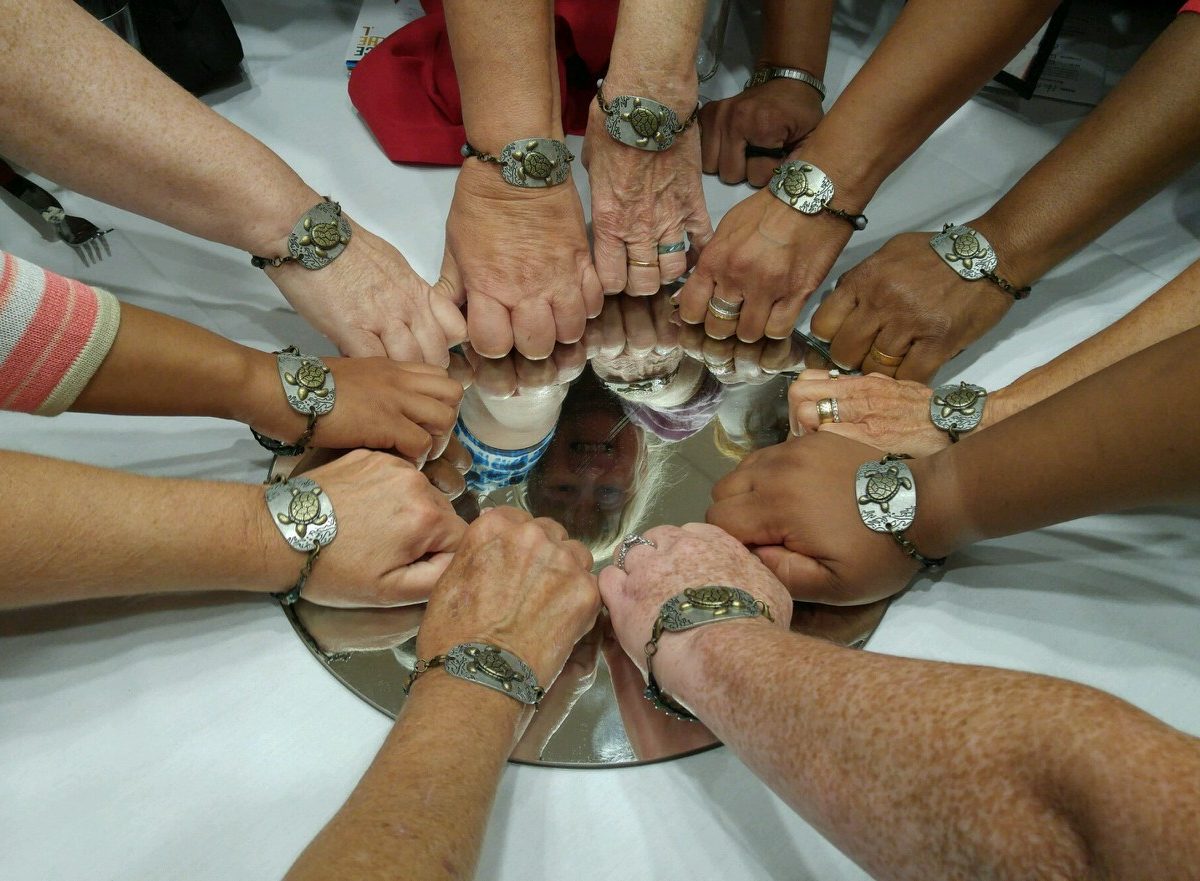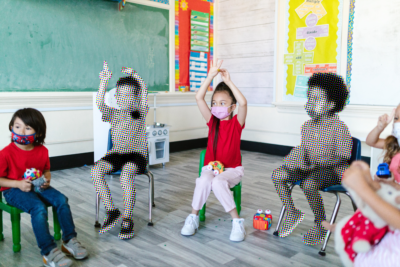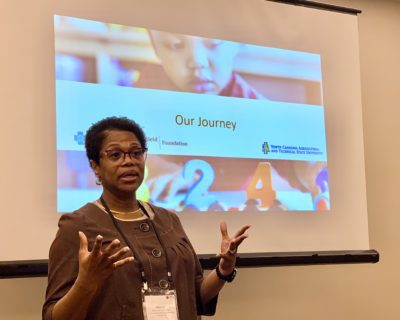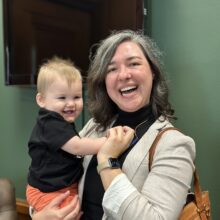
|
|
Since 2005 the Healthy Social Behaviors (HSB) project has been a resource for teachers in North Carolina’s licensed child care centers when they need help managing children who exhibit challenging behaviors.
The HSB project was established by the Department of Health and Human Services’ Division of Child Development and Early Education (DCDEE) to reduce the expulsion rate and promote social emotional development of children at licensed child care centers.
According to DCDEE’s most recent data, there are about 4,000 licensed child care centers in North Carolina serving about 200,000 preschool-age children. Based on the most recent census data, that’s 35% of preschool-age children in the state.
Keeping students in their classrooms and supporting their social emotional learning (SEL) is a priority for DCDEE because early childhood is a period when significant neurological development occurs. During this time, it’s crucial for children to spend time with responsive adults who know how to support their development.
When children are removed from their educational settings at this age, the harm to their development can have lifelong impacts, including placing them in the preschool-to-prison pipeline.
The promise of the pyramid model
Smokie Brawley, statewide project manager for HSB, has been with the initiative since its founding and has seen the many ways in which her team makes a difference in the lives of teachers, students, and families.
“We have happier classrooms of children with fewer challenging behaviors, and we have happier families,” Brawley says of communities who have worked with HSB.
To achieve these outcomes, HSB relies on what is known as the pyramid model. It’s a nationally recognized evidence-based framework of practices designed to support healthy social and emotional development in young children.
The model consists of three tiers built on the foundation of an effective workforce that has systems and policies in place to support each tier.
The first tier is focused on creating the high quality environments and nurturing, responsive relationships that are essential to every child’s developmental needs.
The second tier is about creating targeted emotional supports that prevent challenging behaviors from developing among the children most at risk of developing them.
The third tier is for individualized interventions specific to the small number of children who are not sufficiently supported in the lower tiers.
HSB works at every level of the pyramid model through training, coaching, and consulting. Team members can also link families and teachers to additional resources that may be needed in the third tier.
“Implementation of the pyramid model shows that not only do children develop better social emotional competencies when teachers are both educated and coached on how to implement those best practices,” Brawley said, “teachers are better satisfied, better able to manage the complexities of being an early childhood education professional, and families are happier.”
Brawley said adherence to the pyramid model can also address one aspect of the current child care crisis — keeping teachers in the high-demand, low-pay field of early education.
“Teachers stay longer in a classroom because they’re just not managing as much distraction and aggression and assertiveness in the classroom,” Brawley said. “That becomes disabling and leads to depression and discontent and all the other things that teachers deal with, in addition to the complexities of teaching and the low wages in early childhood ed.”
‘You’re gonna affect the future’
When a teacher at a licensed child care site has tried everything they can think of to support a child who is demonstrating challenging behaviors, a behavior specialist from HSB can help.
HSB assigns a behavior specialist to each of the 14 DCDEE regions of the state. Those specialists are available to go into licensed child care centers at the request of providers, learn about the challenges teachers are facing from a particular student, observe the classroom, and provide support, resources, and strategies to the teacher.
This can help teachers keep students in their classrooms, rather than relying on suspensions and expulsions to maintain positive learning environments.
That’s what motivated Renae Lingafelt-Beeker to join HSB alongside Brawley in 2005.
“The preschool expulsion rate was so high in North Carolina, and there needed to be something done proactively,” Lingafelt-Beeker said. “They wanted to put something into place to keep preschool-aged children in school where they can learn their social and emotional skills to be their best once they got into the [K-12] school system.”
Behavior specialist Kyndra Boyette was inspired by her own experience as a Head Start teacher and as the mother of a child diagnosed with ADHD at a young age.
“I wanted to study and gain insight about why children acted the way that they acted and why they would display certain behaviors for some, but if you made a meaningful connection with them you could get through to them when another teacher couldn’t or even administrator couldn’t,” Boyette said. “That kind of fueled my passion to learn more about meaningful connections and building relationships and making those social and emotional differences in children.”
Sonia Sumner, another HSB behavior specialist, emphasized that the work isn’t just about helping children and their families, but the teachers.
“I will say the biggest success that I have seen from my years of doing this job is when teachers come back to me and they told me, ‘I was gonna quit, but now I’m not,’” Sumner said.
Sumner said she can relate to the teachers because she herself was once a preschool teacher who was prepared to quit over a 3-year-old student’s challenging behaviors.
She described the student swearing with “an excellent vocabulary,” kicking her teaching assistant (a Marine Corps veteran) “right in his behind,” and spitting in her face.
When she told her director she wanted to quit, the director reminded her that she was an adult and the student was barely 3 years old. That prompted Sumner to try a different approach with the student, focusing on his positive traits.
“This little boy, he was really my inspiration to help children with those behaviors,” Sumner said.
She later learned from a chance encounter with the student’s mother that he had gone on to college where he was earning top grades.
“I can’t take credit, but I can say we didn’t give up on him,” Sumner said. “And if I can help other teachers to realize that no matter how bad it is, you’re gonna affect the future, that’s something that strikes me as very powerful.”
Sign up for Early Bird, our newsletter on all things early childhood.
‘The beauty of the project’
Most of the work HSB does is at the top level of the pyramid model, where teachers, students, and families are receiving individualized guidance, resources, and support.
“That’s a triage approach to change of social emotional teaching practices,” Brawley said. “And the triage approach does not teach a teacher how to do something that meets all the needs.”
Because the top level of the pyramid is defined by individualized supports, working there does not always give teachers skills and strategies that can be applied to other challenges they may face in the future. It only addresses the specific challenges of a particular student.
In 2019, DCDEE increased HSB’s funding enough for them to double their staff and begin providing sitewide training and coaching that focuses on the foundation and lower tiers of the pyramid model.
HSB now offers intensive pyramid model training to the entire staffs of licensed child care centers.
After a staff has been trained, they’re assigned a “fidelity coach” from HSB to help them implement what they’ve learned. The goal is for the staff to take ownership of the pyramid model, eventually phasing out the need for HSB’s support.
This sitewide training is important because, according to Brawley, “Even after doubling our staff, in most counties in North Carolina we still have a waiting list that we can’t serve.”
While this type of training is a newer addition to HSB’s scope of work, the fidelity coaches already have success stories.
Hortense Lucas is a former behavior specialist and current fidelity coach who has been with HSB since its inception.
“Teaching teachers has just been a domino effect to the children, to the parents, to the administrators, even to the community,” Lucas said. “I think that’s the beauty of the project.”
Brawley said she hopes to continue expanding HSB’s services to meet the needs of communities who are seeking support for the social emotional development of young children.
“The science tells us that social emotional development is best and most often encouraged in the birth to five years,” Brawley said. “And so the more that we can do in early care and education to support those competencies developing, the better off children are.”
Recommended reading




